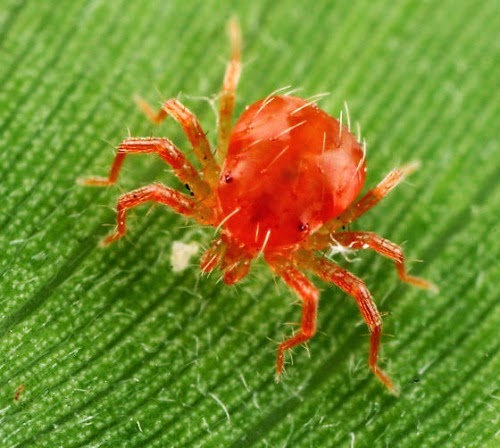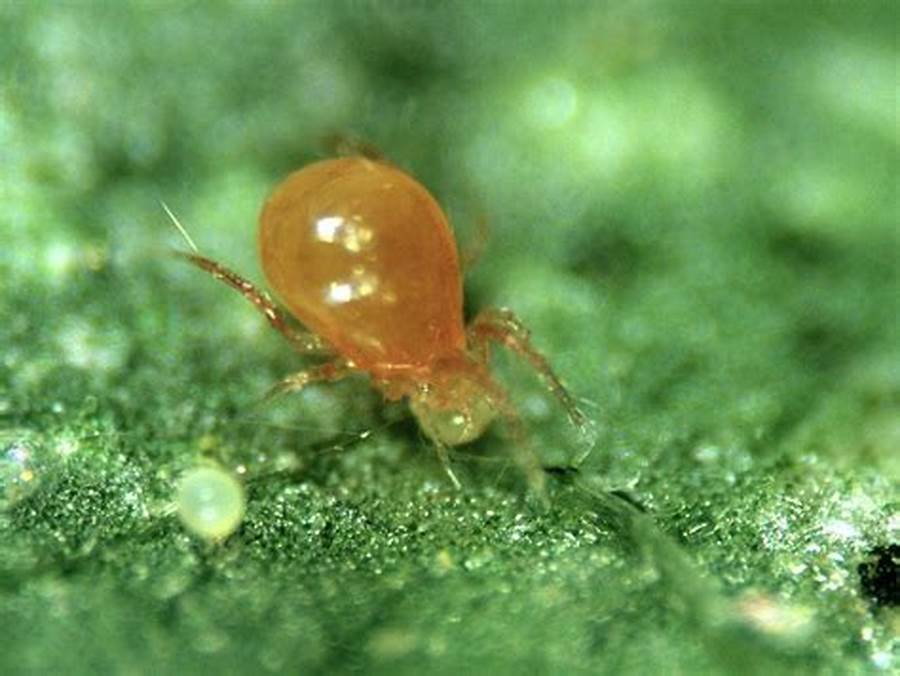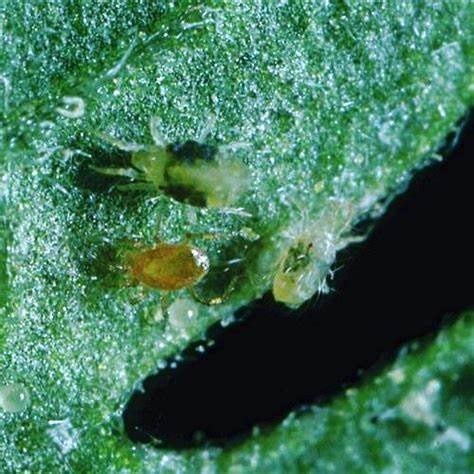Did you know spider mites can destroy crops when there are just 25-30 per leaf? These tiny pests can quickly harm plant health, turning leaves yellow and even killing plants if not controlled. But, there’s a strong ally against spider mites – their natural predators.

Ladybugs and predatory mites can eat up to 100 spider mites daily. This makes them a great, eco-friendly way to fight these pests. Using predatory mites has cut down miticide use by over 90%. It has also saved growers about a million dollars each year. Let’s use nature’s pest control experts to protect our crops.
Understanding Spider Mite Predators
Spider mites are a big problem for gardeners and farmers. They eat the chlorophyll in plant leaves, causing damage. These tiny arachnids can quickly form large colonies, with hundreds of mites in one spot.
Their hunger can stress plants. This leads to bronzed leaves, less photosynthesis, and even the death of small trees in bad cases.
The Damaging Impact of Spider Mites
Spider mites are tiny but can cause big problems. They suck the cell contents from leaves and create webs on leaves, twigs, and fruit. This stops the plant from making food through photosynthesis.
This leads to less growth, fewer yields, and, in extreme cases, the death of the plant.
Biological Pest Control: A Safer Alternative
Using insecticides to control spider mites can be tricky because they become resistant quickly. Luckily, there are natural predators that are safer and more effective. Predatory mites and beneficial insects like ladybugs and lacewings eat spider mites, keeping their numbers down.
By using Spider Mite Predators and Integrated Pest Management techniques, growers can use fewer harmful pesticides. This Biological Pest Control approach protects plants, the environment, and people’s health.
The Number One Spider Mite Predator: Phytoseiulus PersiMilis
Phytoseiulus persimilis is the top choice for fighting spider mites. It has been used in many crops since 1967, especially in greenhouses. It breeds and eats quickly, making it a powerful tool for control.
Rapid Breeding and Immediate Feeding
Phytoseiulus persimilis targets spider mites that make lots of webs. An adult female can eat up to five adult spider mites or 20 young ones or eggs daily at 20°C. This fast eating and breeding helps it beat spider mite populations quickly.
Optimal Temperature Range and Application
This predatory mite works best between 13 and 27°C and fails above 30°C. The amount to use (Spidex, Spidex Vital, Spidex Boost) varies from 2-50 per m^2 and depends on the climate, crop, and spider mite count. It’s best to talk to a Koppert advisor or distributor for the right application strategy.

Over 75% of European greenhouse veggies use Phytoseiulus persimilis against spider mites. In California, it’s also used in strawberries, along with Neoseiulus californicus. Its high eating rate and hunting skills make it the top choice for spider mite control.
Preventative Biocontrol: Amblyseius Californicus
Amblyseius californicus is a powerful predator mite that fights against spider mites. It works well in a variety of temperatures, making it perfect for early pest control.
This mite can live without spider mites for a long time. You can use it before spider mites even show up. It eats pollen, so it has food even when there are no spider mites around. It can work in temperatures from 10°C to 33°C, fitting many growing places.
You can get Amblyseius californicus in bottles or breeder sachets. These can be hung on your plants. They slowly release the predators over weeks, keeping them fighting spider mites.
Using Amblyseius californicus with Phytoseiulus persimilis makes pest control even better. Amblyseius californicus starts fighting early, and Phytoseiulus persimilis quickly lowers spider mite numbers when they get high.
Adding Amblyseius californicus to your pest control plan helps you fight spider mites early. This approach keeps your crops or garden healthy and cuts down on chemical use.
Spider Mite Predators for Cool Conditions: Amblyseius Andersoni
Amblyseius andersoni is a top choice for fighting spider mites in cool weather. It excels in low temperatures, perfect for growers dealing with spider mite problems in cooler areas.
Low-Temperature Effectiveness
Amblyseius andersoni works well even at 6°C (42°F) and up to 40°C (104°F). This means it’s effective in a wide temperature range. When other predators can’t handle the cold, Andersoni steps in to control spider mites.
Limitations and Combined Use
Andersoni is great for cool temperatures but has its limits. It’s less effective when spider mites are many and doesn’t like to go into their webs. To improve its performance, it’s often paired with other mites like Phytoseiulus persimilis. These mites are better at handling large spider mite outbreaks in warm weather.
Using Amblyseius andersoni with other predators helps growers manage spider mites in all temperatures. This approach is sustainable and good for the environment.
Integrating Spider Mite Predators
Using Amblyseius californicus and Phytoseiulus persimilis is key to fighting spider mites. These predatory mites help keep spider mites away. By adding them at the right time, you can protect your plants for a long time.
Early Release of Amblyseius Californicus
Start using Amblyseius californicus early in the growing season. These mites come in sachets that release hundreds of predators over 4 weeks. Even if you don’t see many spider mites yet, adding Amblyseius californicus often can stop them from becoming a big problem.
Targeted Introduction of Phytoseiulus Persi Milis
When spider mites get worse, it’s time for Phytoseiulus persimilis. Use them when it’s warm enough (above 15°C or 59°F) and spider mites are around. You might need to add more Phytoseiulus persimilis until you see them hunting spider mites on your plants.
Using Amblyseius californicus and Phytoseiulus persimilis together makes a strong Biocontrol plan. This way, you can keep spider mite numbers down and protect your crops.
Transition to Effective Spider Mite Predators
Switching to effective Spider Mite Predators is key to keeping your plants safe. By picking the right predators for your plants, you can fight off pests well. This means choosing predators that fit your growing conditions and pest issues.
The Phytoseiulus persimilis is a top choice for fighting spider mites. It breeds fast and eats spider mite eggs, larvae, and adults. It loves warm, humid places, making it perfect for greenhouses and indoor gardens.
Amblyseius californicus is great for preventing spider mite problems. It sets up early and keeps spider mites under control. It works well in many growing conditions, giving your plants lasting protection.
In cooler areas, Amblyseius andersoni is a good pick. It works well in cold weather, ideal for outdoor gardens or cooler climates. But, it might not be enough for big infestations. Using it with other predators might be needed.
Adding these Spider Mite Predators to your pest control plan is key for lasting, eco-friendly control. Start with Amblyseius californicus early to prevent problems. Then, add Phytoseiulus persimilis or Amblyseius andersoni as needed. This way, you can fight spider mites without harmful chemicals.
Using Spider Mite Predators is a smart, science-backed way to help your plants and the environment. By knowing the strengths of each predator and adding them to your pest control plan, you can keep pests away for good.
Conclusion
Spider mites can be tough pests, but using Spider Mite Predators can help control them in a green way. It’s important to know the strengths and limits of these predators. Then, use them smartly in your Integrated Pest Management plan.
Using predators like Phytoseiulus persimilis and Amblyseius californicus can protect your plants. It also cuts down on harmful chemicals. This Biological Control method fights spider mites now and helps the ecosystem later.
When moving to spider mite predators, watch your plants closely. Change your release plans if needed, and be patient. With a good plan, you can beat spider mite problems and have a pest-free garden or landscape. Keep an eye out, use nature’s power, and you’ll keep your garden healthy and full of life.
